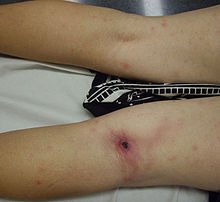en
names in breadcrumbs

Rickettsia sibirica is a species of Rickettsia.[1] This bacterium is the etiologic agent of North Asian tick typhus, which is also known as Siberian tick typhus.[2] The ticks that transmit it are primarily various species of Dermacentor and Haemaphysalis.[3]
 Inoculation eschar on popliteal area and discrete maculopapular elements in patient with lymphangitis infected with Rickettsia sibirica mongolitimonae
Inoculation eschar on popliteal area and discrete maculopapular elements in patient with lymphangitis infected with Rickettsia sibirica mongolitimonae Rickettsia sibirica is a species of Rickettsia. This bacterium is the etiologic agent of North Asian tick typhus, which is also known as Siberian tick typhus. The ticks that transmit it are primarily various species of Dermacentor and Haemaphysalis.